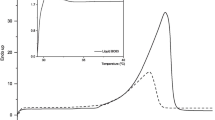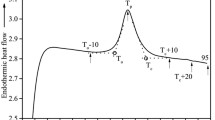Abstract
Differential scanning calorimetry (DSC) has become a popular tool to investigate thermal transitions in food ingredients such as gelatin. Upon heating commercial gelatin samples beyond glass transition (T g) and melting (T m) temperatures, a relatively large endothermic transition (T i) can be observed. We have observed that both the peak temperature and the enthalpy of the T i transition are influenced by the integrity of the seal of the DSC pans used for the analysis. This study shows that escape of moisture from the DSC pan appears to be responsible for this effect. The effect of different types of DSC pans, as well as technique of sealing them on the T i transition were evaluated using DSC, SDT, and TG–MS.





Similar content being viewed by others
References
Eastoe JE. Chemical constitution of gelatin. In: Ward AG, Courtis A, editors. The science and technology of gelatin. London: Academic; 1977. p. 73–82.
Michon C, Cuvelier G, Relkin P, Launay B. Influence of thermal history on the stability of gelatin gels. Int J Biol Macromol. 1997;20:259–64.
Baziwane D, He Q. Gelatin: the paramount food additive. Food Rev Int. 2003;19:423–35.
D’Cruz NM, Bell LN. Thermal unfolding of gelatin in solids as affected by the glass transition. J Food Sci. 2005;70:E64–8.
Apostolov AA, Fakirov S, Vassileva E, Patil RD, Mark JE. DSC and TGA studies of the behavior of water in native and crosslinked gelatin. J Appl Polym Sci. 1999;71:465–70.
Tseretely GI, Smirnova OI. DSC study of melting and glass transition in gelatins. J Therm Anal Calorim. 1992;38:1189–201.
Nazzal S, Wang Y. Characterization of soft gelatin capsules by thermal analysis. Int J Pharm. 2001;230:35–45.
Fakirov S, Cagiao ME, Calleja FJB, Sapundjieva D, Vassileva E. Melting of gelatin crystals below glass transition temperature: a direct crystal-glass transition as revealed by microhardness. Int J Polym Mater. 1999;43:195–206.
Cuppo F, Venuti M, Cesàro A. Kinetics of gelatin transitions with phase separation: T-jump and step-wise DSC study. Int J Biol Macromol. 2001;28:331–41.
Sobral PJA, Habitante AMQB. Phase transitions of pigskin gelatin. Food Hydrocoll. 2001;15:377–82.
Rahman MS, Al-Saidi GS, Guizani N. Thermal characterisation of gelatin extracted from yellowfin tuna skin and commercial mammalian gelatin. Food Chem. 2008;108:472–81.
Dai C-A, Chen Y-F, Liu M-W. Thermal properties measurements of renatured gelatin using conventional and temperature modulated differential scanning calorimetry. J Appl Polym Sci. 2006;99:1795–801.
Farkas J, Mohácsi-Farkas C. Application of differential scanning calorimetry in food research and food quality assurance. J Therm Anal Calorim. 1996;47:1787–803.
Crighton JS, Wilburn FW. The role of heat transfer in the production of DSC curves. Thermochim Acta. 1992;203:1–5.
Yu L, Christie G. Measurement of starch thermal transitions using differential scanning calorimetry. Carbohydr Polym. 2001;46:179–84.
MacNeil DD, Trussler S, Fortier H, Dahn JR. A novel hermetic differential scanning calorimeter (DSC) sample crucible. Thermochim Acta. 2002;386:153–60.
Marshall AS, Petrie SE. Thermal transitions in gelatin and aqueous gelatin solutions. J Photogr Sci. 1980;28:128–34.
Slade L, Levine H. Polymer-chemical properties of gelatin in foods. In: Pearson AM, Dutson TR, Bailey AJ, editors. Advances in meat research: collagen as a food. vol. 4, New York: AVI; 1987, pp. 251–66.
Slade L, Levine H, Finley JW. Protein-water interactions: water as a plasticizer of gluten and other polymers. In: Phillips RD, Finley JW, editors. Protein quality and the effects of processing. New York: Marcel Dekker, Inc.; 1989. p. 9–124.
Rahman MS, Al-Saidi G, Guizani N, Abdullah A. Development of state diagram of bovine gelatin by measuring thermal characteristics using differential scanning calorimetry (DSC) and cooling curve method. Thermochim Acta. 2010;509:111–9.
Al-Saidi G, Rahman MS, Al-Alawi A, Guizani N. Thermal characteristics of gelatin extracted from shaari fish skin: effects of extraction conditions. J Therm Anal Calorim. 2011;104:593–603.
le Parlouër P. TG-DSC as a new method of investigation of polymers and resins. J Therm Anal. 1988;33:1085–90.
Riesen R, Vogel K, Schubnell M. DSC by theTGA/SDTA851e considering mass changes. J Therm Anal Calorim. 2001;64:243–52.
Xie W, Pan W-P. Thermal characterization of materials using evolved gas analysis. J Therm Anal Calorim. 2001;65:669–85.
Giron D. Applications of thermal analysis and coupled techniques in pharmaceutical industry. J Therm Anal Calorim. 2002;68:335–57.
TA Instruments, New Castle DE. Operator’s Guide: DSC high volume pan kit. PN 900826.001 Rev. H. Issued April 2003.
Acknowledgements
The authors are grateful to TA Instruments, New Castle, DE for generating the simultaneous DSC–TG data on calfskin gelatin using their Q600SDT instrument, as well as Kraft Foods Global Inc. for their support.
Author information
Authors and Affiliations
Corresponding author
Rights and permissions
About this article
Cite this article
Mukherjee, I., Rosolen, M. Thermal transitions of gelatin evaluated using DSC sample pans of various seal integrities. J Therm Anal Calorim 114, 1161–1166 (2013). https://doi.org/10.1007/s10973-013-3166-4
Received:
Accepted:
Published:
Issue Date:
DOI: https://doi.org/10.1007/s10973-013-3166-4




